Last Updated: July 21, 2025
Early one morning in July 1968, an unassuming green mountain in northern Costa Rica suddenly awoke and became the legendary Arenal Volcano. If you are visiting the town of La Fortuna, you’ll be able to get a close up of Arenal’s now ashy gray peak from many different spots. One place of particular interest is the Arenal 1968 Trail. This series of hiking trails brings you through forested areas and across historic lava fields that buried much of the surrounding jungle during the dramatic eruptions of 1968. In this post, we’ll give you all the details you need to plan your visit to Arenal 1968.
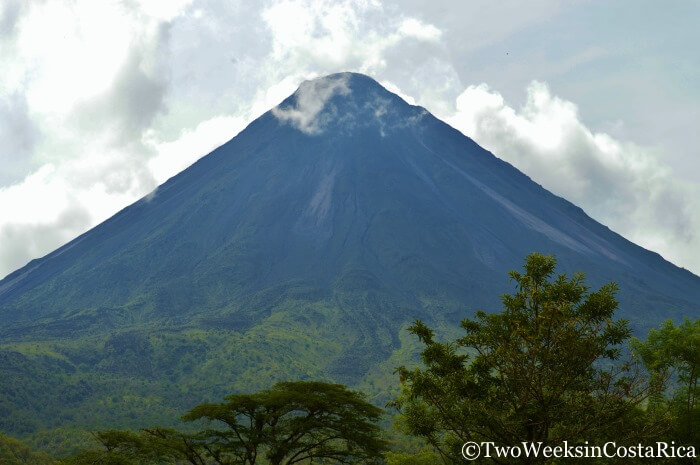
Location and Access
Arenal Volcano is located about 2.5 hours from the main airport in San Jose and about the same distance from the smaller international airport in Liberia. The closest major destination is La Fortuna.
Access to the 1968 Trail is about 25 minutes from La Fortuna on the western side of the volcano. From the downtown, you take Route 142 west towards Lake Arenal and then a left onto the dirt road leading to Arenal Volcano National Park and El Castillo. About 1.25 km (3/4 of a mile) down the road, you will find the visitors center and parking area for the 1968 Trail. The private reserve is marked with a big sign on the left so you can’t miss it.
Tip: The dirt road getting to the 1968 Trail is flat and bumpy, but a 4-wheel drive vehicle is not necessary. If you need a car, rent one from Adobe Rent a Car and make sure to use our Discount page to save some money.
The Trails at Arenal 1968
The big draw of the Arenal 1968 Trail is the fairly close views of Arenal Volcano. These views give you a look at the old lava flows, now hardened into rock, coming down the slope of the volcano and into the valley. On the edge of the lava field are also a lot of different sized volcanic boulders scattered around.
It’s crazy to think about, but these rocks were shot into the air during eruptions at speeds of up to 2,000 km (1,200 miles) per hour. One large rock even left a sizable crater that you can see on the trail. To get to these features, there are a couple of ways to go.
Here is a link to the trail map.
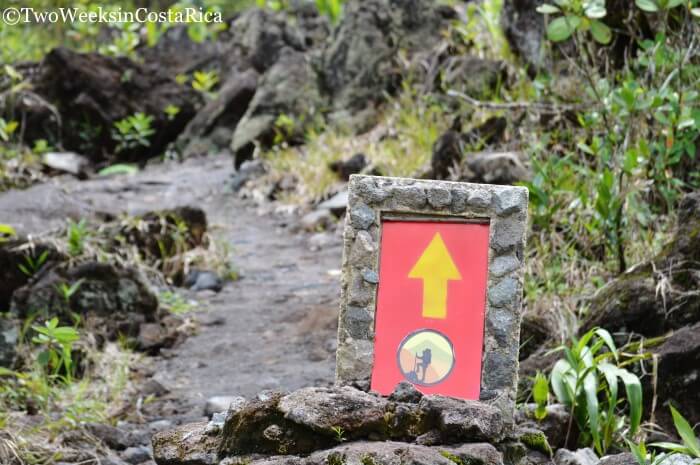
The Bosque 1968 Trail
This trail (the Forest Trail) sets out through some fields and into the thick forest before climbing up to the lava fields and viewpoint. Along the way, it passes Lago Los Patos or Duck Lake, which is about 22 meters (72 feet) deep and was formed when the eruptions took place.
This trail is 4.7 km (3 miles) long and is a moderate-to-difficult hike since the terrain has some steep portions as well as lots of roots and rocks. It’s well worth it, though, if you are looking for birds and animals. Wildlife tends to hide in the shade of the forest and around the small lake.
The Colada 1968 Trail
Another way to reach the viewpoint and lava fields is to take the Colada Trail. This is a slightly shorter trail at 4 km (2.4 miles) and is strenuous at times but not as difficult as the Bosque Trail.
Colada translates to wash or flow, and this trail is so named because it has the best views of the 1968 flows and the volcano.
Note: All hiking trails around Arenal Volcano are limited to areas surrounding the base for safety reasons. Although there hasn’t been any major activity since 2010, the volcano is still considered active and is known to release toxic gases and hot steam near the summit.
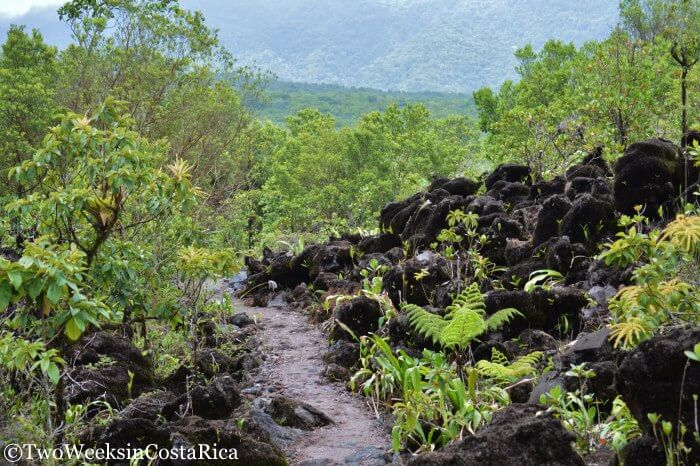
What You’ll See
No matter which trail you take, the good news is that you will end up at the same viewpoints since both trails overlap in the middle. From the highest point, at the Lava Flow Summit, you can normally get a spectacular view of Arenal Volcano. Unfortunately, it became clouded over right as we arrived but we were still able to see parts of it as we hiked.
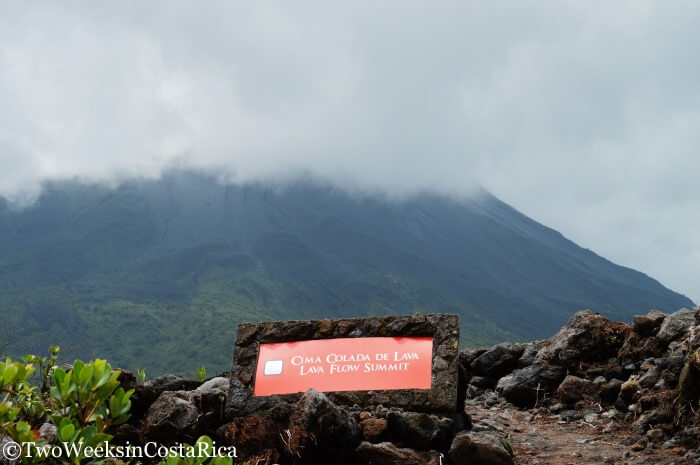
Tip: It’s not uncommon for the top of the volcano to be clouded over due to local weather conditions. The Arenal area has slightly different weather patterns so it is generally the most rainy during the dry season on the Pacific slope (December to April). Many people say that the best times to see the volcano are September and October. We have found from many visits to Arenal that it really just depends, and conditions can change from one minute to the next.
During our visit, we hiked the Bosque Trail since our good friend Harris, a serious hiker, was with us. We all really enjoyed this trail, mostly because of the flora and fauna that we spotted, but also because it was a great workout.
Some of the things we saw were lots of birds, including the Magpie Jay, Tropical King Bird, Montezuma Oropendola, Thick-billed Seed Finch, and an Anhinga in the small lake. We also saw some cool insects like butterflies, leaf-cutter ants, gigantic blue bumblebees, and this crazy beetle.
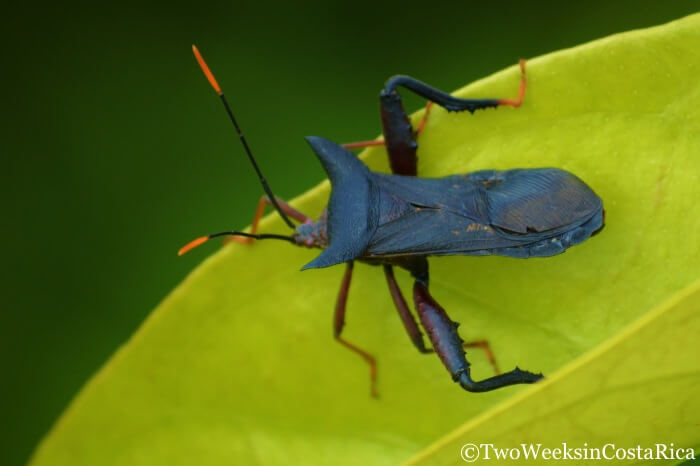
Near the lava flow and volcano viewing area, we also took in a nice view of Lake Arenal to the west. This is Costa Rica’s largest lake but wasn’t always that way. In 1979, Costa Rica’s electric company built a new hydroelectric dam that tripled the lake’s size. In the process, two towns (Nuevo Arenal and Tronadora) were relocated to higher ground. To this day, remnants of those old roads and buildings are still at the bottom of the lake.
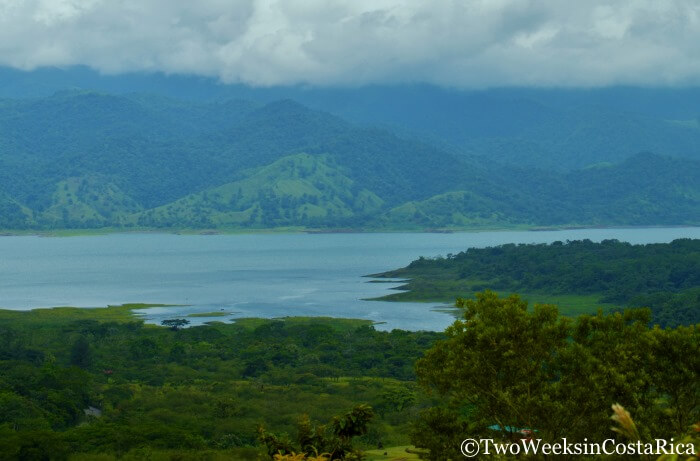
Planning Your Visit to the 1968 Trail
Hours
Arenal 1968 is open every day from 7:30 a.m. to 5:00 p.m. Last Entrance: 4:00 p.m.
Cost
Admission: $26/adult. $15/children ages 6-11.
See below for more affordable Arenal hikes.
What to Wear/Bring
We recommend a hat, sunscreen, insect repellent, and water.
Here’s a link to our post on Packing Your Day Pack for more tips.
Restaurant
The property has a small, open-air restaurant with nice views of the volcano and Lake Arenal.
They serve drinks and basic food (e.g., smoothies, coffee, sandwiches, empanadas, burgers, shrimp tacos, nachos). *If you’re not hiking, they’ll charge $7 to pass through the gate where the restaurant is. If you’re hiking anyway, there’s no additional charge.
Other Arenal Volcano Hikes
Here are a couple of more options for nice volcano hikes:
Mirador El Silencio Trail: Offers a similar close-up view of the volcano along the lava flow trail. The trails here are similar in difficulty (mostly easy to moderate). The admission price is more affordable at about $10/adult. Children under 7 are free.
Arenal Volcano National Park: A mostly flat trail – the easiest option in the area. The national park now has an accessible viewing platform with a nice volcano view. Admission is $15/adult, $5/child.
Conclusion
The 1968 Trail is an amazing place to hike and learn more about the mighty Arenal Volcano’s ferocious history. Imagine what it was like that historic day back in 1968 when a mountain literally blew its top and released its fury on the nearby jungle and farms. Altogether, 73 people lost their lives in the tragic eruptions reminding us that Mother Nature rules all.
Have you hiked the 1968 Trails near Arenal Volcano? Let us know what you thought in the comments below.
Looking for more to do in the area? Check out these posts:
19 Things to Do in La Fortuna: Learn about other activities like lesser known hikes, hanging bridges, zip lining, and lots more.
Ecotermales: A Small, Upscale Hot Springs Resort – The natural hot springs in La Fortuna are perfect for relaxing after a hike like this one!
La Fortuna Waterfall: A Tropical Oasis – One of La Fortuna’s top attractions, this dramatic cascade is not to be missed.
Mistico Hanging Bridges: A Treetop Rainforest Experience – One of the best ways to experience the rainforest canopy is on hanging bridges.
La Fortuna Tours – Check out this list of our favorite things to do in La Fortuna/Arenal that we can help you book.
Rio Celeste Waterfall – One of Costa Rica’s most beautiful waterfalls is only a day trip away from La Fortuna. Read this article to learn about the hike to the bright blue Rio Celeste.
Things to Do – Get even more activity ideas for your trip. Our Things to Do articles cover 150+ options for everything from wildlife tours and sanctuaries to local coffee and chocolate tours.



